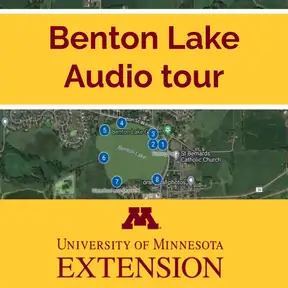Stop 4: Lookout Point
Stop 4: Lookout Point
Continuing paddling along the north side of the lake, we will pass next to a viewing area that marks the end of the walking path. This area is a great place to view the entirety of Benton Lake! There are even signs detailing species living within the lake, although not all of them benefit the lake’s ecosystem. Carver County Water Management Organization staff found invasive species in Benton Lake, including Zebra Mussels, Curlyleaf Pondweed, Eurasian Watermilfoil, and Common Carp. An invasive species is any species introduced into an ecosystem that is not found natively there and causes negative impacts on the populations of native species. To prevent aquatic invasive species from spreading, clean your watercraft when leaving this lake and any others. Remove any plants found on the watercraft and rinse the boat off. These invasive species can find their way onto the bottom of boats and get introduced into new areas, where they will cause even more havoc. It is unlawful to transport prohibited invasive species within the state of Minnesota. We will specifically discuss the invasive carp within the lake and more steps the BLWC is taking to solve this problem.
Before Benton Lake became what it is today, and long before the founding of Cologne, the area was part of the North Central Hardwood Forests ecoregion. This area covered most of Central Minnesota, Central Wisconsin, and some of Michigan. It was characterized by having temperate broadleaf forests as well as mixed forests. Sugar Maple, red oak, quaking aspen, paper birch, American elm, and ironwood are all common tree species of this ecoregion. Over time, Benton Lake formed into what it is today. Many years have gone into the creation of its ecosystem. It is vital to understand the necessity of its preservation.

